 |
 |
|
The Distribution of PageRank Regarding Search Engine Optimisation
Up to this point, it has been described how the number of pages and the number of inbound and outbound links, respectively, influence PageRank. Here, it will mainly be discussed in how far PageRank can be affected for the purpose of search engine optimisation by a website's internal linking structure.
|
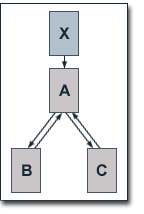
|
In most cases, websites are hierachically structured to a certain extend, as it is illustrated in our example of a web site consisting of the pages A, B and C. Normally, the root page is withal optimised for the most important search phrase. In our example, the optimised page A has an external inbound link from page X which has no other outbound links and a PageRank of 10. The pages B and C each receive a link from page A and link back to it. If we set the damping factor d to 0.5 the equations for the single pages' PageRank values are given by |
PR(A) = 0.5 + 0.5 (10 + PR(B) + PR (C))
PR(B) = 0.5 + 0.5 (PR(A) / 2)
PR(C) = 0.5 + 0.5 (PR(A) / 2)
Solving the equations gives us the follwing PageRank values:
PR(A) = 8
PR(B) = 2.5
PR(C) = 2.5
It is generally not advisable to solely work on the root page of a site for the purpose of search engine optimisation. Indeed, it is, in most cases, more reasonable to optimise each page of a site for different search phrases.
|
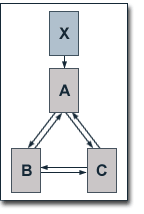
|
We now assume that the root page of our example website provides satisfactory results for its search phrase, but the other pages of the site do not, and therefore we modify the linking structure of the website. We add links from page B to page C and vice versa to our formerly hierarchically structured example site. Again, page A has an external inbound link from page X which has no other outbound links and a PageRank of 10. At a damping factor d of 0.5, the equations for the single pages' PageRank values are given by |
PR(A) = 0.5 + 0.5 (10 + PR(B) / 2 + PR(C) / 2)
PR(B) = 0.5 + 0.5 (PR(A) / 2 + PR(C) / 2)
PR(C) = 0.5 + 0.5 (PR(A) / 2 + PR(B) / 2)
Solving the equations gives us the follwing PageRank values:
PR(A) = 7
PR(B) = 3
PR(C) = 3
The result of adding internal links is an increase of the PageRank values of pages B and C, so that they likely will rise in search engine result pages for their targeted keywords. On the other hand, of course, page A will likely rank lower because of its diminished PageRank.
Generally spoken, PageRank will distribute for the purpose of search engine optimisation more equally among the pages of a site, the more the hierarchically lower pages are interlinked.
Well Directed PageRank Distribution by Concentration of Outbound Links
It has already been demonstrated that external outbound links tend to have negative effects on the PageRank of a website's web pages. Here, it shall be illustrated how this effect can be reduced for the purpose of search engine optimisation by the systematic arrangement of external outbound links.
|
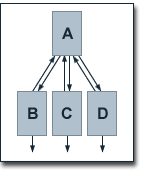
|
We take a look at another hierarchically structured example site consisting of the pages A, B, C and D. Page A has links to the pages B, C and D. Besides a link back to page A, each of the pages B, C and D has one external outbound link. None of those external pages which receive links from the pages B, C and D link back to our example site. If we assume a damping factor d of 0.5, the equations for the calculation of the single pages' PageRank values are given by |
PR(A) = 0.5 + 0.5 (PR(B) / 2 + PR(C) / 2 + PR(D) / 2)
PR(B) = PR(C) = PR(D) = 0.5 + 0.5 (PR(A) / 3)
Solving the equations gives us the follwing PageRank values:
PR(A) = 1
PR(B) = 2/3
PR(C) = 2/3
PR(D) = 2/3
|
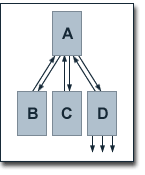
|
Now, we modify our example site in a way that page D has all three external outbound links while pages B and C have no more external outbound links. Besides this, the general conditions of our example stay the same as above. None of the external pages which receive a link from pages D link back to our example site. If we, again, assume a damping factor d of 0.5, the equations for the calculations of the single pages' PageRank values are given by |
PR(A) = 0.5 + 0.5 (PR(B) + PR(C) + PR(D) / 4)
PR(B) = PR(C) = PR(D) = 0.5 + 0.5 (PR(A) / 3)
Solving these equations gives us the follwing PageRank values:
PR(A) = 17/13
PR(B) = 28/39
PR(C) = 28/39
PR(D) = 28/39
As a result of our modifications, we see that the PageRank values for each single page of our site have increased. Regarding search engine optimisation, it is therefore advisable to concentrate external outbound links on as few pages as possible, as long as it does not lessen a site's usabilty.
Link Exchanges for the purpose of Search Engine Optimisation
For the purpose of search engine optimisation, many webmasters exchange links with others to increase link popularity. As it has already been shown, adding links within closed systems of web pages has no effects on the accumulated PageRank of those pages. So, it is questionable if link exchanges have positive consequences in terms of PageRank at all.
|
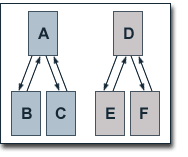
|
To show the effects of link exchanges, we take a look at an an example of two hierarchically structured websites consisting of pages A, B and C and D, E and F, respectively. Within the first site, page A links to pages B and C and those link back to page A. The second site is structured accordingly, so that the PageRank values for its pages do not have to be computed explicitly. At a damping factor d of 0.5, the equations for the single pages' PageRank values are given by |
PR(A) = 0.5 + 0.5 (PR(B) + PR(C))
PR(B) = PR(C) = 0.5 + 0.5 (PR(A) / 2)
Solving the equations gives us the follwing PageRank values for the first site
PR(A) = 4/3
PR(B) = 5/6
PR(C) = 5/6
and accordingly for the second site
PR(D) = 4/3
PR(E) = 5/6
PR(F) = 5/6
|
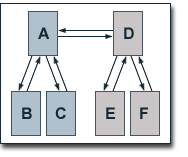
|
Now, two pages of our example sites start a link exchange. Page A links to page D and vice versa. If we leave the general conditions of our example the same as above and, again, set the damping factor d to 0.5, the equations for the calculations of the single pages' PageRank values are given by |
PR(A) = 0.5 + 0.5 (PR(B) + PR(C) + PR(D) / 3)
PR(B) = PR(C) = 0.5 + 0.5 (PR(A) / 3)
PR(D) = 0.5 + 0.5 (PR(E) + PR(F) + PR(A) / 3)
PR(E) = PR(F) = 0.5 + 0.5 (PR(D) / 3)
Solving these equations gives us the follwing PageRank values:
PR(A) = 3/2
PR(B) = 3/4
PR(C) = 3/4
PR(D) = 3/2
PR(E) = 3/4
PR(F) = 3/4
We see that the link exchange makes pages A and D benefit in terms of PageRank while all other pages lose PageRank. Regarding search engine optimisation, this means that the exactly opposite effect compared to interlinking hierachically lower pages internally takes place. A link exchange is thus advisable, if one page (e.g. the root page of a site) shall be optimised for one important key phrase.
A basic premise for the positive effects of a link exchange is that both involved pages propagate a similar amount of PageRank to each other. If one of the involved pages has a significantly higher PageRank or fewer outbound links, it is likely that all of its site's pages lose PageRank. Here, an important influencing factor is the size of a site. The more pages a web site has, the more PageRank from an inbound link is distributed to other pages of the site, regardless of the number of outbound links on the page that is involved in the link exchange. This way, the page involved in a link exchange itself benefits lesser from the link exchange and cannot propagate as much PageRank to the other page involved in the link exchange. All the influencing factors should be weighted up against each other bevor one trades links.
Finally, it shall be noted that it is possible that all pages of a site benefit from a link exchange in terms of PageRank, whereby also the other site taking part in the link exchange does not lose PageRank. This may occur, when the page involved in the link exchange already has a certain number of external outbound links which don't link back to that site. In this case, less PageRank is lost by the already existing outbound links.
PageRank and Google are trademarks of Google
Inc.
This site is not affiliated with Google Inc.
|

